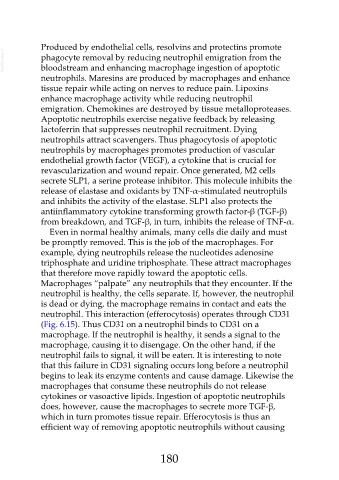Page 180 - Veterinary Immunology, 10th Edition
P. 180
Produced by endothelial cells, resolvins and protectins promote
VetBooks.ir phagocyte removal by reducing neutrophil emigration from the
bloodstream and enhancing macrophage ingestion of apoptotic
neutrophils. Maresins are produced by macrophages and enhance
tissue repair while acting on nerves to reduce pain. Lipoxins
enhance macrophage activity while reducing neutrophil
emigration. Chemokines are destroyed by tissue metalloproteases.
Apoptotic neutrophils exercise negative feedback by releasing
lactoferrin that suppresses neutrophil recruitment. Dying
neutrophils attract scavengers. Thus phagocytosis of apoptotic
neutrophils by macrophages promotes production of vascular
endothelial growth factor (VEGF), a cytokine that is crucial for
revascularization and wound repair. Once generated, M2 cells
secrete SLP1, a serine protease inhibitor. This molecule inhibits the
release of elastase and oxidants by TNF-α-stimulated neutrophils
and inhibits the activity of the elastase. SLP1 also protects the
antiinflammatory cytokine transforming growth factor-β (TGF-β)
from breakdown, and TGF-β, in turn, inhibits the release of TNF-α.
Even in normal healthy animals, many cells die daily and must
be promptly removed. This is the job of the macrophages. For
example, dying neutrophils release the nucleotides adenosine
triphosphate and uridine triphosphate. These attract macrophages
that therefore move rapidly toward the apoptotic cells.
Macrophages “palpate” any neutrophils that they encounter. If the
neutrophil is healthy, the cells separate. If, however, the neutrophil
is dead or dying, the macrophage remains in contact and eats the
neutrophil. This interaction (efferocytosis) operates through CD31
(Fig. 6.15). Thus CD31 on a neutrophil binds to CD31 on a
macrophage. If the neutrophil is healthy, it sends a signal to the
macrophage, causing it to disengage. On the other hand, if the
neutrophil fails to signal, it will be eaten. It is interesting to note
that this failure in CD31 signaling occurs long before a neutrophil
begins to leak its enzyme contents and cause damage. Likewise the
macrophages that consume these neutrophils do not release
cytokines or vasoactive lipids. Ingestion of apoptotic neutrophils
does, however, cause the macrophages to secrete more TGF-β,
which in turn promotes tissue repair. Efferocytosis is thus an
efficient way of removing apoptotic neutrophils without causing
180

